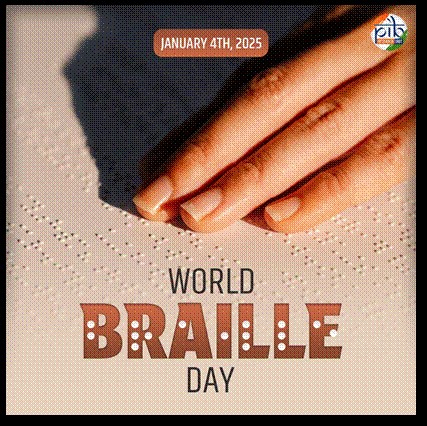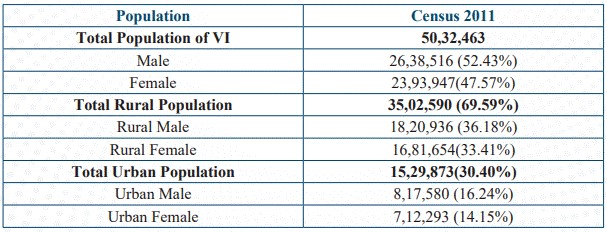Ministry of Social Justice & Empowerment
World Braille Day
Honoring Inclusion, Innovation, and Independence
Posted On:
03 JAN 2025 7:39PM by PIB Delhi
World Braille Day, observed on January 4th, commemorates the birthday of Louis Braille, the visionary who developed a tactile script that revolutionized communication for blind and partially sighted individuals. Celebrated globally since 2019, this day highlights the significance of Braille in empowering visually impaired individuals to access education, information, and opportunities, fostering their full participation in society.

What is Braille?
Braille is a tactile representation of alphabetic and numerical symbols using six dots to represent each letter and number, and even musical, mathematical and scientific symbols. Braille (named after its inventor in 19th century France, Louis Braille) is used by blind and partially sighted people to read the same books and periodicals as those printed in a visual font.
Significance of Braille
According to the 2011 Census, there are 50,32,463 persons with visual impairment in India. Persons with disabilities, accounting for over a billion people worldwide, face significant barriers to accessing healthcare, education, and employment. They often experience higher rates of violence, neglect, and poverty, making them among the most marginalized in society. World Braille Day, celebrated since 2019, is observed to raise awareness of the importance of Braille as a means of communication in the full realization of the human rights of blind and partially sighted people.

Demographic Status for Persons with Visual Impairment
Some of the Important Initiatives for the Empowerment of Visually Impaired Persons
Government of India has undertaken a comprehensive array of initiatives to empower visually impaired individuals, emphasizing their rights, education, employment, and overall well-being. Key initiatives include:
Making Information Accessible
- Collaboration with the National Association for the Blind aimed to make approximately 10,000 pages of documents, including government schemes and legal reliefs, accessible to persons with visual disabilities.
- MoUs signed with Inclusive Science, Mission Accessibility, and the National Association for the Blind, focused on enhancing mobile application accessibility through AI technology. Another MoU with Vision Divyang Foundation aimed to use AI to guide PwDs on eligibility for government schemes.
National Institute for the Empowerment of Persons with Visual Disabilities (Divyangjan)
The National Institute for the Empowerment of Persons with Visual Impairment (NIEPVD) (Divyangjan) is working in the field of visual disability for the education, training, rehabilitation & empowerment of persons with visual impairment since 1943. During the period 2023-24, 2,94,388 persons (New Cases, Follow-up & Supportive Services) were benefitted through different services/programmes under the institute.
Model School for the Visually Handicapped (MSVH)
The Model School for the Visually Handicapped (MSVH) is imparting education to children with visual impairment from the Bal Vatika to senior secondary level, representing a broad spectrum of society. Apart from providing free education, boarding & lodging, uniforms, books and equipment, the school offers a modicum of plus curriculum activities for all-round development of its students. During the year 2023-24, Model school has provided education to 243 children with visual impairment.
Braille Development Unit
The Braille Development Unit is an important constituent of the Department of Special Education and Research. It contributed to the development of Braille Codes in different Indian languages. In addition to the current publications, the institute is in the process of developing a ‘Manual on Bharti Braille’. This manual is designed to further support Braille literacy and standardization across India.
National Accessible Library
NIEPVD is also hosting a National Accessible Library to provide learning materials in various accessible formats Braille, large print, audio and E-pub to persons with visual impairment. The Library serves over 55,000 members and houses approximately 1,58,901 Braille volumes, 20,784 print books and more than 7100 audio titles. In addition, the Institute is also hosting an Online Braille Library- Sugamya Pustkalaya having 6,79,120 titles.
Braille Production
NIEPVD has put in place an impressive infrastructure for printing Braille textbooks and magazines. It comprises the Central Braille Press established in 1951, the Regional Braille Press established in 2008 at Chennai and 25 other Braille Presses established by the Government. With the combined efforts of these Braille Presses, the Braille literature in the following 14 languages is being published:
- Assamese
- Bangla
- English
- Garo
- Hindi
- Khasi
- Kannada
- Lusai
- Nagamese
- Punjabi
- Sanskrit
- Telugu
- Tamil
- Urdu
Conclusion
The initiatives reflects that India is making strides toward ensuring that visually impaired individuals can live with dignity, independence, and equality. As we celebrate the achievements of Louis Braille and countless individuals who continue to champion accessibility, let us pledge to build a society where everyone has the opportunity to thrive, regardless of their abilities.
References
https://pib.gov.in/PressReleasePage.aspx?PRID=2088877
https://www.un.org/en/observances/braille-day/background
Niepvd Annual report 2023-24: https://niepvd.nic.in/annual-report/
Click here to see in PDF:
Santosh Kumar/ Sarla Meena/ Madiha Iqbal
(Release ID: 2089993)
Visitor Counter : 2759